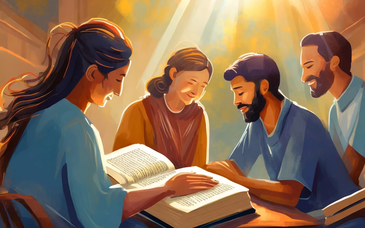In the eight chapter of Matthew's gospel, he writes about the story of Jesus Christ crossing the Galilee and entering the land of the Gergesenes. In this land, Jesus cast demons out of two demoniacs and into some pigs. The pigs subsequently ran off a cliff and died.
Where did the Gergesenes live? Where is this cliff? Are we sure the Gergesenes lived there and not the Gadarenes? This essay is to clarify the authenticity of this disputed passage of scripture.
In order to understand what was meant by Matthew, we should analyze the original, Greek manuscripts. Since most English speaking readers don't know Greek, here is the passage in English, first. The King James Version (KJV) is disputably the closest text to the original, so we will quote from it.
Matthew 8:28-34 "And when he was come to the other side into the country of the Gergesenes, there met him two possessed with devils, coming out of the tombs, exceeding fierce, so that no man might pass by that way. And, behold, they cried out, saying, What have we to do with thee, Jesus, thou Son of God? art thou come hither to torment us before the time? And there was a good way off from them an herd of many swine feeding. So the devils besought him, saying, If thou cast us out, suffer us to go away into the herd of swine. And he said unto them, Go. And when they were come out, they went into the herd of swine: and, behold, the whole herd of swine ran violently down a steep place into the sea, and perished in the waters. And they that kept them fled, and went their ways into the city, and told every thing, and what was befallen to the possessed of the devils. And, behold, the whole city came out to meet Jesus: and when they saw him, they besought him that he would depart out of their coasts."
This passage seems very straightforward. The words are clear and easy to understand. However, there are a few questions that should be answered (especially, the ones above).
Where were the Gergesenes living? "The Atlas of the Bible Lands" shows that Gergesa was a small town on the eastern shore of the Sea of Galilee. It was at the foot of some hills, too. It's not far from the present-day Golan Heights.
The Easton's Bible Dictionary associates Gergesa with modern day Khersa. Here is a large mountain, 2,000 feet high, that slopes steeply downward and into the Sea of Galilee. At this location, there is only 40 feet of land from the base of the mountains to the water. In English, this place is called Kursi. There is a shrine here that dedicates this miracle of Jesus Christ.
In the Greek text, "Gergesenes" is translated from "Gergesenos". According to the Strong's Concordance Dictionary, the Gergesenes were also called the Girgashites (or Girgasites). Seeing these people called the Girgashites and then the Gergesenes isn't unheard of. It is fairly common for place names and people names to "evolve" over time. For instance, Jebus was renamed Jerusalem, Abram was renamed Abraham, the Israelities were renamed the Jews, etc.
It should be noted that the KJV Bible uses the word "Gergasenes" to designate this place and people. The NIV Bible uses the word "Gedarenes". This is because there are apparently some different, Greek manuscripts that use the following three words to describe these people. They translate into Gergasenes, Gedarenes and Gerasenes.
Assuming all these texts are correct, the Gadarenes were from a town called Gadara. This town is situated about 5 miles southeast of the Sea of Galilee. The actual city of Kursi is about 10 miles from the city of Gadara. They are both in the same region.
So, what's the big deal? Well, here's the most controversial point.
Matthew's gospel uses the word Gergasenes and Luke's gospel uses the word Gadarenes. The words in the KJV represent the same words that are in the Greek texts. However, the passage in Luke is less disputed because there aren't any Greek manuscripts that use a word besides "Gadarenes". Here are the exact verses.
Matthew 8:28 "And when he was come to the other side into the country of the Gergesenes, there met him two possessed with devils, coming out of the tombs, exceeding fierce, so that no man might pass by that way."
Luke 8:25 "And they arrived at the country of the Gadarenes, which is over against Galilee."
These passages can easily be complementary passages. The word "country" is the Greek word "chora" which can also mean region or territory. The region of the Gergesenes and the region of the Gadarenes can occupy this 10 mile stretch of land without stretching the context of the words.
Lastly, Mark's gospel uses the word "Gadarenes" (KJV) to describe this place and people. However, in the NIV, the word "Gerasenes" is used!
The city of Gerasa, where the Gerasenes lived, is about 25 miles southeast of Gadara. If the NIV was correct, the pigs had to run about 30 miles before they could enter the water! Obviously, this is another translation error.
When we use the KJV and take the word "Gadarenes" to the Greek manuscripts, we see the word "Gadarenos". This makes perfect sense because Gadara and Gergasa are in the same region, near the water and near the Sea of Galilee.
In conclusion, is the KJV has the closest translation to the original scriptures and the best text to use when doing research. The only better text is the actual Hebrew and Greek manuscripts. The NIV has allowed many errors and changes. Unfortunately, the changes in the NIV (only a couple of the many changes and omissions were mentioned here) have corrupted the text.
The two demoniacs were in the territory of the Gergasenes and the Gadarenes. The cliff is located at present-day Kursi. This is on the shore of the Sea of Galilee. The only question that remains is why the NIV translators chose the word "Gerasenes".

